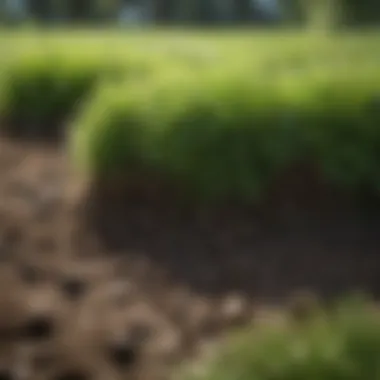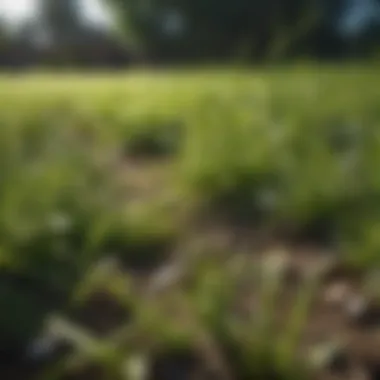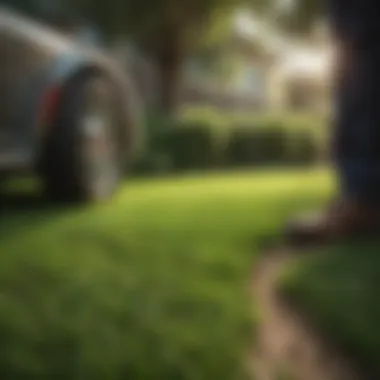Unlocking the Benefits of Retaining Grass Clippings for a Lush Lawn


Overview of the Topic
Current Status and Challenges
An examination of the current status reveals a prevalent trend of bagging grass clippings post-mowing, leading to significant environmental downsides. The act of disposing of grass clippings indiscriminately not only adds to landfills but also deprives the soil of valuable nutrients essential for its well-being. Furthermore, the challenges associated with this practice include misconceptions about lawn aesthetics, lack of awareness regarding the benefits of grass clippings, and the prevalence of outdated lawn care practices that perpetuate harmful habits.
Sustainable Solutions
In contrast, the sustainable solution lies in a simple yet powerful act - leaving grass clippings on your lawn. This eco-friendly approach promotes natural processes like nutrient cycling and soil enrichment, fostering a self-sustaining ecosystem within your green space. By harnessing nature's potential and reevaluating traditional lawn care norms, individuals can contribute positively to environmental conservation efforts on a micro-scale.
Impact and Importance
The impact of leaving grass clippings on your lawn reverberates across multiple dimensions. From bolstering soil health and reducing fertilizer dependency to enhancing biodiversity and mitigating greenhouse gas emissions, this practice champions environmental harmony and resource optimization. Its importance transcends individual lawns, resonating with broader conservation narratives and underscoring the pivotal role of sustainable practices in shaping a greener future for all.
Introduction
The practice of leaving grass clippings on your lawn is a topic that holds significant implications for sustainable lawn maintenance. Not just a matter of convenience, this approach offers a myriad of benefits that extend beyond mere aesthetics. Understanding the importance of grass clippings involves delving into its role in enhancing soil health, promoting nutrient recycling, and simplifying overall lawn care routines. By harnessing the potential of these natural resources, homeowners can foster a greener and healthier environment right in their own backyard.
Understanding the Importance of Grass Clippings
Nutrient Content in Grass Clippings
Delving into the composition of grass clippings reveals a treasure trove of essential nutrients that can benefit your lawn's vitality. These clippings are not merely waste but a rich source of nitrogen, potassium, and phosphorus, key ingredients for robust plant growth. By leaving them on the lawn, you are essentially providing your grass with a natural and organic form of fertilization, free from harmful chemicals. This nutrient-rich content acts as a sustainable nourishing agent for your soil, enhancing its overall health and fertility. Embracing this natural fertilizer alternative contributes to the long-term resilience of your lawn, promoting a well-balanced ecosystem conducive to flourishing greenery.
Role in Soil Health
Beyond the surface aesthetics, grass clippings play a pivotal role in nourishing the very foundation of your lawn - the soil. As these clippings break down over time, they infuse the soil with valuable organic matter, fostering a nutrient-rich environment for beneficial microorganisms. This organic matter acts as a natural soil conditioner, improving its structure, water retention capacity, and aeration. By integrating grass clippings back into the soil, you are essentially fortifying its health from within, laying the groundwork for sustainable growth and vitality. In essence, grass clippings serve as a vital component in the ecological cycle of your lawn, contributing to its overall well-being and vibrancy.


Benefits of Leaving Grass Clippings
Leaving grass clippings on your lawn has numerous benefits that can significantly impact soil health, nutrient recycling, and overall lawn maintenance. By understanding the importance of this practice, you can make informed decisions to promote a greener and healthier lawn.
Enhanced Soil Health
Increased Organic Matter
Increased organic matter plays a vital role in soil health by enriching the soil with essential nutrients, promoting microbial activity, and enhancing moisture retention. The incorporation of organic matter from grass clippings improves soil structure, fertility, and overall ecosystem health. This natural amendment fosters a balanced soil environment conducive to healthy plant growth, making it a sustainable choice for maintaining a lush lawn.
Improved Soil Structure
Improved soil structure is critical for optimal plant growth as it influences water infiltration, root development, and nutrient availability. By leaving grass clippings on the lawn, you can enhance soil aggregation, reduce compaction, and encourage beneficial soil organisms. The improved soil structure resulting from the decomposition of clippings promotes aeration, drainage, and root penetration, creating a fertile ground for a thriving lawn.
Nutrient Recycling
Natural Fertilization
Natural fertilization from grass clippings returns essential nutrients, such as nitrogen, phosphorus, and potassium, back to the soil. This eco-friendly practice mimics the natural nutrient cycle, fostering sustainable soil fertility and plant growth. By letting the clippings decompose on the lawn, you provide a continuous source of organic nutrients that support long-term soil health and plant vitality.
Reduced Need for Chemical Fertilizers
By recycling nutrients through grass clippings, you can reduce the reliance on chemical fertilizers, minimizing environmental impact and promoting eco-friendly lawn care. This reduction in chemical inputs not only saves time and resources but also contributes to soil quality and biodiversity. Embracing natural nutrient recycling through leaving grass clippings is a proactive step towards sustainable lawn management.
Time-Saving Lawn Care
Reduced Mowing Frequency
Leaving grass clippings on the lawn can lead to a reduction in mowing frequency as the clippings decompose naturally, providing nourishment for the soil and grass. This time-saving benefit allows for more efficient lawn maintenance, enabling you to spend less time mowing and more time enjoying a healthy, vibrant lawn.


Less Yard Waste to Manage
By forgoing the collection and disposal of grass clippings, you can significantly reduce yard waste and minimize the burden on waste management systems. This sustainable approach not only saves time and effort but also contributes to environmental conservation by decreasing organic waste sent to landfills. Managing yard waste through grass recycling is a practical and eco-conscious choice for maintaining a clean and sustainable outdoor space.
Best Practices for Leaving Grass Clippings
Another crucial aspect of best practices for leaving grass clippings is adhering to a regular mowing schedule. By maintaining a consistent mowing routine, you can ensure that grass clippings are of appropriate length for effective decomposition. This practice prevents the accumulation of thick thatch layers and allows clippings to break down gradually, nourishing the soil beneath. Additionally, a regular mowing schedule promotes a more uniform grass height, creating a visually appealing lawn and reducing the risk of weed growth. Striking a balance between lawn maintenance and environmental consciousness, a regular mowing schedule plays a pivotal role in optimizing the benefits of leaving grass clippings on your lawn.
Proper Mowing Techniques
Mulching Mowers
Delving deeper into mulching mowers unveils their distinct advantage in sustainable lawn care practices. The key characteristic of mulching mowers lies in their ability to finely shred grass clippings, promoting accelerated decomposition. This finely shredded grass acts as a natural mulch, retaining moisture in the soil and enhancing its nutrient content. The unique feature of mulching mowers is their multitasking capability, where they not only mow but also recycle grass clippings simultaneously. This efficient process minimizes yard waste, fosters soil health, and reduces external inputs, making mulching mowers a valuable asset in the quest for greener, healthier lawns.
Regular Mowing Schedule
Discussing the significance of a regular mowing schedule sheds light on its impact on sustainable lawn maintenance. The key characteristic of a regular mowing schedule is its ability to consistently manage grass growth, ensuring optimal lawn health. By mowing at regular intervals, you prevent grass from becoming overgrown, leading to uneven cuts and stress on the turf. This practice helps maintain grass health, promotes root growth, and contributes to a lush, vibrant lawn. The unique feature of a regular mowing schedule is its role in preventing thatch buildup, as timely mowing keeps grass at an ideal height for healthy decomposition. While adhering to a regular mowing routine demands dedication, the long-term benefits far outweigh the effort, resulting in a resilient and aesthetically pleasing lawn.
Dealing with Excessive Clippings
Addressing the management of excessive grass clippings is essential for maintaining a balanced ecosystem within your lawn. Two primary methods commonly employed are composting and grasscycling. These practices offer practical solutions to handle surplus clippings, turning potential waste into valuable resources for your lawn.
Composting
Exploring the merits of composting reveals its pivotal role in sustainable waste management. The key characteristic of composting is its ability to transform organic material, including grass clippings, into nutrient-rich compost. This compost serves as a natural fertilizer, enriching the soil with essential nutrients and promoting microbial activity. The unique feature of composting lies in its ability to reduce waste sent to landfills while nurturing soil health. By composting grass clippings, you contribute to the circular economy of your lawn, minimizing environmental impact and fostering long-term sustainability.
Grasscycling


Examining the benefits of grasscycling showcases its efficiency in returning valuable nutrients to the soil. The key characteristic of grasscycling is its incorporation of finely chopped clippings back into the lawn, enriching the soil with organic matter. This process not only provides essential nutrients for grass growth but also helps in moisture retention and weed suppression. The unique feature of grasscycling is its time-saving aspect, as it eliminates the need for bagging or disposal of clippings. By grasscycling, you promote a closed-loop system within your lawn, creating a self-sustaining ecosystem that thrives on natural inputs.
In essence, by adopting proper mowing techniques, such as utilizing mulching mowers and maintaining a regular mowing schedule, and implementing effective strategies like composting and grasscycling, you can elevate your lawn care practices to new heights of sustainability. Embracing these best practices not only benefits your lawn's health and appearance but also contributes to a greener, more environmentally conscious approach to landscaping. Let us continue to explore innovative methods to harmonize our outdoor spaces with nature, promoting the well-being of our environment and ourselves.
Common Misconceptions Debunked
Leaving grass clippings on your lawn is often misunderstood, sparking various misconceptions among homeowners. Addressing these myths is crucial in enlightening individuals about the positive impacts of this practice on the environment and overall lawn health. By debunking common misconceptions, this article aims to provide a well-rounded perspective on the practice of leaving grass clippings on your lawn. Shedding light on the benefits and dispelling myths will empower readers to make informed decisions for greener and healthier lawn care routines.
Myth: Grass Clippings Cause Thatch
When comparing thatch and grass clippings, it is important to understand their distinct characteristics and contributions to lawn maintenance. Unlike thatch, which consists of dead grass roots, stems, and debris that accumulate above the soil, grass clippings are freshly cut and decompose quickly to provide essential nutrients back to the soil. Grass clippings act as a natural mulch, aiding in moisture retention and reducing the need for additional fertilizers. This sustainable practice not only promotes soil health but also minimizes waste, making it a beneficial choice for environmentally-conscious homeowners.
Thatch Prevention Strategies
Effective thatch prevention is essential for maintaining a healthy lawn ecosystem. Implementing proper watering and mowing techniques can help prevent thatch buildup. Additionally, using mulching mowers that finely shred grass clippings into smaller pieces facilitates quicker decomposition, promoting nutrient return to the soil. By adopting these strategies, homeowners can prevent thatch accumulation while reaping the benefits of leaving grass clippings on their lawns.
Myth: Clippings Hinder Grass Growth
Contrary to popular belief, leaving grass clippings on the lawn does not impede grass growth. In fact, grass clippings contribute to nutrient recycling by returning essential elements like nitrogen and potassium back to the soil. This process, known as nutrient return, enriches the soil, enhancing its fertility and promoting healthy grass growth. By mulching grass clippings instead of bagging and disposing of them, homeowners can create a balanced lawn nutrition cycle, supporting sustainable lawn care practices.
Balanced Lawn Nutrition
Maintaining a balanced lawn nutrition regimen is key to fostering lush and vibrant grass growth. Grass clippings, when decomposed naturally, release valuable nutrients into the soil, reducing the need for synthetic fertilizers. This nutrient-rich cycle not only supports the overall health of the lawn but also reduces chemical input, aligning with eco-friendly lawn care principles. Embracing a balanced lawn nutrition approach by incorporating grass clippings into the soil contributes to long-term lawn resilience and environmental sustainability.
Conclusion
Embracing Sustainable Lawn Practices
Environmental Benefits
Delving into the realm of environmental benefits associated with leaving grass clippings on your lawn unveils a pivotal contribution to the overarching eco-friendly agenda. The unique aspect of environmental benefits lies in their inherent ability to naturally nourish the soil, fostering a harmonious relationship between grass, soil, and microorganisms. This synergy not only minimizes the need for external additives but also aids in reducing the carbon footprint associated with traditional lawn care practices. Such a sustainable choice not only benefits the immediate surroundings but resonates with a broader environmental ethos, making it a prudent choice for those committed to green living practices. The salient feature of environmental benefits is their cost-effective and organic nature, ensuring a well-rounded enhancement of soil health and ecosystem balance within the context of this article.
Long-Term Lawn Resilience
Scrutinizing the facet of long-term lawn resilience in the context of leaving grass clippings on your lawn sheds light on its pivotal role in fortifying the endurance and vitality of your outdoor space. The key characteristic of long-term lawn resilience lies in its ability to gradually build soil structure and foster microbial activity, laying the groundwork for a robust and sustainable lawn ecosystem. This choice, recognized for its enduring benefits, bolsters the lawn's innate ability to withstand environmental stressors, such as extreme weather conditions and pest infestations, ensuring long-lasting health and vibrancy. The unique feature of long-term lawn resilience lies in its versatility and adaptability, offering a proactive approach to lawn care that goes beyond mere aesthetics. While presenting numerous advantages in terms of reduced maintenance and increased resilience, long-term lawn resilience also highlights the need for consistent dedication to sustainable lawn practices within the scope of this article.



